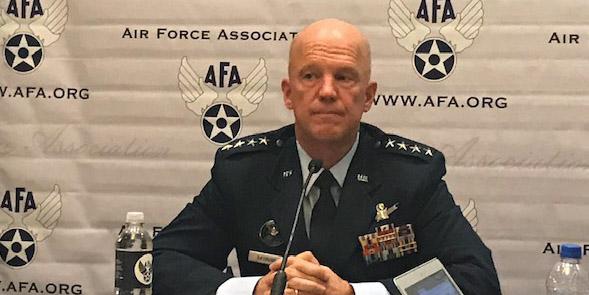U.S. Space Command Gears Up To Operate
The U.S. military’s 11th combatant command, the U.S. Space Command, which the Defense Department stood up on August 29, is taking shape. Led by Gen. John W. "Jay" Raymond, USAF, who is also the commander of the Air Force Space Command, Peterson Air Force Base, Colorado, the Space Command has a singular focus of protecting and defending the space domain, Gen. Raymond explained.
The commander spoke with reporters at the Air Force Association’s Air, Space and Cyber conference on September 17 at National Harbor, Maryland.
The command is “moving out with a sense of urgency towards” initial operating capability (IOC) and full operational capability (FOC), the general said. “We don’t have a specific date in mind for when IOC or FOC will happen. It will be a conditions-based declaration, not a time-based declaration. So, we will lay out the conditions that we need to declare IOC and the same thing for FOC and [we will be ready] when we reach those conditions.”
As far as initial staffing levels, the command started with just shy of 300 employees at the command headquarters level. Below that level, Space Command has several operation centers—such as the National Defense Center—which adds about 300 more people. “Although those numbers are still being finalized, it is will be consistent with what other combatant commands have,” Gen. Raymond observed.
According to the general, the command will concentrate on “producing combat-ready forces prepared to fight for and preserve U.S. and alliance space superiority.” The command’s role of defending U.S. and allied interests in space and delivering combat power to the joint international forces will require a well-prepared force that specializes just in that domain, the commander noted. And while the Air Force has always had great space operators, he said, for the Space Command, the leaders will work to develop space warfighters so that they have a comprehensive understanding of the space domain. Space warfighters have to have a deep knowledge of how to operate space-based capabilities, as well as a key understanding of adversaries’ abilities in space.
The adversarial threats are real, and in particular, the command takes the threat from China “very seriously,” Gen. Raymond stressed. “The scope, scale and complexity of the threats from China is really concerning. It includes everything from low-end irreversible jamming of satellites and GPS all the way up to kinetic destruction.”
This stance was not a necessity in a previously benign space environment.
As such, Space Command is focusing on expanding its partnerships with key allies. “We are actively working with allies and partners to promote peace and deter aggression, and if necessary fight and win,” the general stated. “Historically we haven’t needed to have partners. In a warfighting domain, in a contested domain, we need partners. We are working really hard with our Five Eyes partners and with France, Germany and Japan.” The Five Eyes nations include Australia, Canada, New Zealand, the United Kingdom and the United States.
Space Command’s participation in war games has demonstrated just how important coalition partners are in space, the commander added. Next month, with Japan and other important partner nations, the Space Command will participate in the Global Sentinel exercise, which is focused on space situational awareness (SSA).
The command’s partnership efforts also apply to training in space-related capabilities. “We have opened up our schoolhouses for more allied training opportunities,” Gen. Raymond offered. “And we have a command and control center that is operated/manned with Five Eyes partners,” he said. The command also has a multilateral collaboration cell at Vandenburg Air Force Base, California, that includes other partner nations.
“We are open for partnerships,” Gen. Raymond emphasized.
Moreover, the United States has many agreements with other countries to share SSA data and services, the commander said.
More in-depth SSA information is necessary in a contested environment, he explained. “If it’s a benign domain without any threat, just knowing where you are sitting is good enough,” the commander said. “I know you are there. And I can make sure that you don’t hit any piece of debris in space, for example. But if it’s a contested domain, you need a lot more than just the address in space of where something is. So, it is making that shift from metric tracking, ….to a much fuller set of information that you need. That is the shift that we are going through. And we are partnering with our allies to be able to do that and get more information. We are [also] partnering with the intelligence community and with the commercial [sector].”
In connection to increased SSA efforts, the command is also pursuing a data strategy to handle new information streams.
In addition, the new combatant commander will play a key role on the Space Development Agency’s (SPA’s) Warfighting Council. “I will have a very strong voice on that council,” in regard to capabilities that meet the Space Command’s requirements, he said. The Defense Department stood up the SPA this spring.
“It is truly an exciting time to be in the space business and I couldn’t be more honored to lead the talented men and women in all the branches in the U.S. military in the Space Force as we further develop Joint Space warfighters,” Gen. Raymond noted. “Space superiority, it is an imperative, a joint warfighting imperative.”





Comments